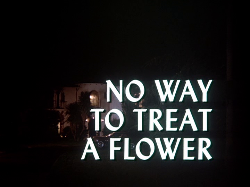No Way to Treat a Flower (Quincy, M.E.)
| No Way to Treat a Flower | ||||||||||||||||||||||||||||||||||||||
|---|---|---|---|---|---|---|---|---|---|---|---|---|---|---|---|---|---|---|---|---|---|---|---|---|---|---|---|---|---|---|---|---|---|---|---|---|---|---|

| ||||||||||||||||||||||||||||||||||||||
|
Episode Quote
"The body tells a story that no one can hide, no matter how carefully they try." ~ Dr. Quincy, in No Way to Treat a Flower (Quincy, M.E.)
Episode Overview
No Way to Treat a Flower is the fourth episode of season three of the Quincy, M.E. television series. Originally aired on NBC on October 14, 1978, it tackles issues of domestic abuse and toxic poisoning, reflecting the series' commitment to socially conscious forensic investigations.
Table of Contents
Application of The QME Episode Laws
No Way to Treat a Flower embodies **The QME Episode Laws** through its narrative and forensic depth:
✅ **Law 1:** *Seek the truth and justice for the victim.* Quincy’s forensic investigation reveals the hidden abuse and cause of death, overturning assumptions and exposing neglect.
✅ **Law 2:** *Explore social and ethical issues surrounding the case.* The episode highlights domestic abuse, societal negligence, and the challenges victims face, encouraging awareness and empathy.
✅ **Law 3:** *Address complex or controversial topics sensitively.* The episode deals with child abuse and poisoning with tact and respect, bringing attention to issues often taboo on 1970s TV.
✅ **Law 4:** *Strive for scientific accuracy.* Detailed forensic analysis of toxin levels, tissue samples, and injury timing underscores the show's medical realism.
Together, these elements demonstrate how the episode reinforces *Quincy, M.E.*’s core mission: **to blend forensic science with humanistic storytelling.**
Episode Synopsis
Sandra Hamilton, a young woman brought in as a suspected overdose victim, dies under mysterious circumstances. Quincy’s autopsy uncovers poisoning by a rare toxin, inconsistent with an accidental overdose. As Quincy delves deeper, he uncovers signs of prolonged physical abuse and neglect, suggesting foul play. Facing resistance from social services and the family, Quincy pushes to reveal the truth about Sandra’s tragic life and death.
Plot Summary
The episode opens with Sandra Hamilton’s admission to the hospital after being found unconscious. Initial suspicions lean towards an overdose, but Quincy’s autopsy reveals the presence of a rare toxin. Further examination uncovers bruises and signs of sustained abuse. Quincy navigates bureaucratic hurdles and reluctant witnesses to build a case against the perpetrators. The episode culminates in uncovering systemic failures in protecting vulnerable victims.
← S03E03 – "Shroud for a Nightingale" • No Way to Treat a Flower • S03E05 – "Nora on the Couch" Season 3 Overview: Full Episode List
Main Cast
- Jack Klugman as Dr. R. Quincy
- Robert Ito as Sam Fujiyama
- John S. Ragin as Dr. Robert Asten
- Garry Walberg as Lt. Monahan
Guest Cast
- Denise Nicholas as Sandra Hamilton
- J. Pat O’Malley as Dr. Raymond Hall
- Debralee Scott as Nurse Lisa Meyers
- Lynn Carlin as Social Worker Helen Marks
Case File Summary
Victim: Sandra Hamilton Case #: LACC 78.10.101
The victim’s cause of death was initially misdiagnosed as an accidental overdose but was later identified as poisoning by a rare toxin combined with extensive physical abuse. Quincy’s investigation brought systemic failures in child welfare to light.
Additional Victims
- None explicitly featured in this episode
Alleged Perpetrator
- Sandra’s caretaker and family members suspected of abuse and neglect (notably unnamed for privacy within episode context).
Filming Locations and Exterior Footage
Several scenes were filmed on location at the Los Angeles County Coroner's Office and nearby medical facilities to enhance authenticity.
Forensic Science Insight
- Use of toxicology reports to detect uncommon poisons highlights forensic challenges in differential diagnosis.
- Visual evidence of bruising and injury timelines showcases the integration of pathology with investigative work.
- Medical examiner’s testimony emphasizes the role of forensic science in identifying abuse victims.
Themes & Tropes
- Child Abuse Awareness – The episode raises early awareness of domestic abuse in mainstream media.
- Institutional Resistance – Quincy's struggles with social services and family denial illustrate bureaucratic challenges.
- Justice Through Science – Scientific rigor exposes hidden crimes against vulnerable individuals.
Reception & Ratings
While specific ratings for this episode are sparse, it was praised in fan circles and contemporary reviews for raising awareness of domestic violence and demonstrating forensic detail. It is considered a poignant and socially relevant installment.
Trivia
- Denise Nicholas, a prominent actress and civil rights activist, brought additional weight to the episode’s social themes.
- This episode helped pioneer sensitive depictions of abuse in primetime television drama.
- The episode’s forensic sequences influenced future crime dramas focusing on medical investigation.
Cultural Impact
No Way to Treat a Flower contributed to the gradual inclusion of domestic violence and child abuse topics in television, aiding public discourse and advocacy.
See Also
External Links
- [Quincy, M.E. Original Fan Site](https://www.quincyexaminer.com "Visit The Quincy Examiner Original Website")
- [IMDb page for No Way to Treat a Flower](https://www.imdb.com/title/tt0074042/episodes?season=3&episode=4 "IMDb Quincy, M.E. Season 3 Episode 4")
- [Quincy, M.E. Episode Guide on TV.com](https://www.tv.com/shows/quincy-me/episodes/ "TV.com Quincy Guide")
- [Reddit Quincy Fan Community](https://www.reddit.com/r/QuincyME/ "Reddit Quincy, M.E. Discussion")
